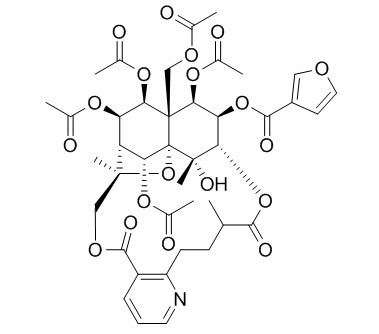Wilforgine
Wilforgine exhibits insecticidal activity of some degree.
Inquire / Order:
manager@chemfaces.com
Technical Inquiries:
service@chemfaces.com
Tel:
+86-27-84237783
Fax:
+86-27-84254680
Address:
1 Building, No. 83, CheCheng Rd., Wuhan Economic and Technological Development Zone, Wuhan, Hubei 430056, PRC
Providing storage is as stated on the product vial and the vial is kept tightly sealed, the product can be stored for up to
24 months(2-8C).
Wherever possible, you should prepare and use solutions on the same day. However, if you need to make up stock solutions in advance, we recommend that you store the solution as aliquots in tightly sealed vials at -20C. Generally, these will be useable for up to two weeks. Before use, and prior to opening the vial we recommend that you allow your product to equilibrate to room temperature for at least 1 hour.
Need more advice on solubility, usage and handling? Please email to: service@chemfaces.com
The packaging of the product may have turned upside down during transportation, resulting in the natural compounds adhering to the neck or cap of the vial. take the vial out of its packaging and gently shake to let the compounds fall to the bottom of the vial. for liquid products, centrifuge at 200-500 RPM to gather the liquid at the bottom of the vial. try to avoid loss or contamination during handling.
Yakugaku Zasshi.2018, 138(4):571-579
Journal of functional foods2018, 171-182
Front Pharmacol.2020, 11:566490.
Phytomedicine.2018, 40:37-47
Evid Based Complement Alternat Med.2021, 2021:5585692.
Int J Mol Sci.2020, 21(19),7070.
Journal of Medical Sciences2024, 44(5):p 222-227.
J Ethnopharmacol.2022, 282:114574.
Pharmacognosy Journal, 2021, 13(5).
Int J Mol Sci.2023, 25(1):162.
Related and Featured Products
Curr Microbiol. 2015 Apr;70(4):571-9.
Effects of plant stress signal molecules on the production of wilforgine in an endophytic actinomycete isolated from Tripterygium wilfordii Hook.f.[Pubmed:
25523369]
The endophytic actinomycete F4-20 was isolated from Tripterygium wilfordii Hook.f. and was confirmed to produce Wilforgine, a secondary metabolite discovered in its host.
METHODS AND RESULTS:
F4-20 showed a close phylogenetic relationship to Streptomyces species.
METHODS AND RESULTS:
To seek elicitors that may enhance the production of Wilforgine in F4-20, four plant stress molecules were applied to the in vitro liquid cultures. Results showed that methyl jasmonate (MeJA), salicylic acid (SA), and hydrogen peroxide (H2O2) inhibited bacterial growth, whereas glutathione (GSH) treatment significantly increased bacterial growth. The Wilforgine contents in the mycelia of F4-20 were reduced by MeJA and GSH but were induced by SA and H2O2. When added in the end of the culture period (7 day), 1 mM SA and 5 mM H2O2 resulted in 69.35 ± 1.71 and 71.80 ± 3.35 µg/g DW of Wilforgine production, 1.55 and 1.60 fold to that of control (44.83 ± 1.35 µg/g DW), respectively.
CONCLUSIONS:
Though this improved production was about 6.5 times lower than that of the natural root (454.00 µg/g dry root bark), it provided an alternative method for the production of valuable plant secondary metabolites.
Acta Entomologica Sinica,2007,50(8):795-800.
Insecticidal activities and active ingredients of Tripterygium hypoglaucum (Levl.) Hutch[Reference:
WebLink]
Isolating insecticidal activities compounds is an important method to discover new pesticides.
METHODS AND RESULTS:
Insecticidal activities and active ingredients of Tripterygium hypoglaucum against six lepidopteran insects were studied with bioassay-guided fractionation methods. The results showed the petroleum extract, methanol extract and acetic ether extract of the root of T. hypoglaucum had antifeedant activity against the 3th instar larvae of Mythimna separata Walker, with the AFC_ 50 value 1 165.7 μg/mL, 104.3 μg/mL and 47.3 μg/mL 24 h after treatment, respectively. The methanol extract of the root bark had contact toxicity to the 4th instar larvae of M. separatar, with the LD_ 50 values 100.4 μg/larva 24 h after treatment. Four sesquiterpenes pyridine alkaloids, i.e., wilfortrine, Wilforgine, wilfordine and wilforine, were isolated from the methanol extract of the root bark of T. hypoglaucum by bioassay-guided fractionation. The bioassay results showed that wilfortrine and Wilforgine had stomach toxicity with the ND_ 50 value 18.1 μg/larva and 7.4 μg/larva, respectively against M. separata; wilfordine and wilforine had topical toxicity with the ND_ 50 value 0.33 μg/larva and 0.06 μg/larva, respectively against M. separata and stomach toxicity with the ND_ 50 value 5.62 μg/larva and 1.24 μg/larva, respectively against Agrotis ypsilon.
CONCLUSIONS:
T. hypoglaucum exhibited insecticidal activity of some degree against the all six lepidopteran insects tested, and the main active ingredients were wilfortrine, Wilforgine, wilfordine and wilforine.
Zhongguo Zhong Yao Za Zhi. 2014 Jun;39(12):2267-74.
Effects of amino acid on growth and secondary metabolites contents of adventitious roots of Tripterygium wilfordii.[Pubmed:
25244757]
The adventitious root of Tripterygium wilfordii was used as experiment material to study effects of various concentration of aspartic acid, isoleucine, cysteine and arginine in MS medium on the growth and triptolide, Wilforgine, wilforine contents of the adventitious roots.
METHODS AND RESULTS:
The results showed that compared with the control, supplemented with 0.25 mmol x L(-1) aspartic acid at 3rd week, the growth of the adventitious roots only accounted for 80%, but the content of triptolide of the adventitious roots and the medium was 1.36, 1.30 times, the content of Wilforgine was 1.16, 1.37 times, the content of wilforine was 1.22, 1.63 times, respectively. At 3rd week 0.05 mmol x L(-1) isoleucine, the growth of adventitious roots was 97.3%, Wilforgine of adventitious roots and medium 1.02, 1.27 times, wilforine 1.36 times and 1.15 times. At 1st week 0.25 mmol x L(-1) cysteine, the growth of the adventitious roots comprised 77.5% of the control, while content of triptolide of adventitious roots reached 1.87 times. At 2nd week 1.00 mmol x L(-1) cysteine, the growth of adventitious roots was 44.6% of the control, the content of wilforine in medium was 2.97 times. At 3rd week 0.50 mmol x L(-1) arginine, the growth of adventitious roots was 124.2%, the content of Wilforgine and wilforine was 1.3, 1.4 times, respectively.



